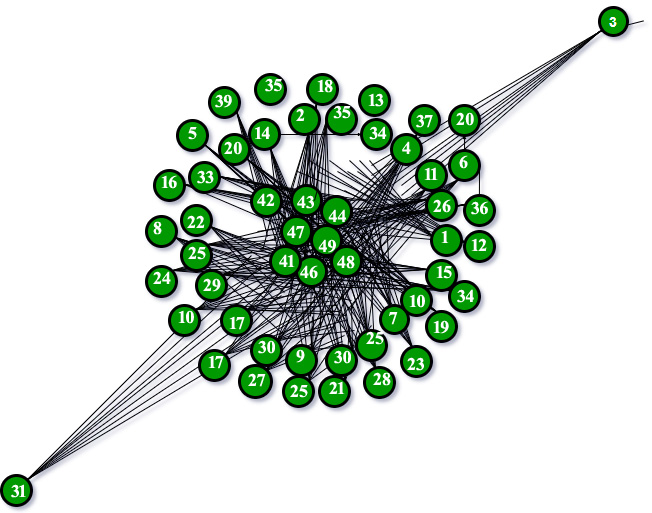Barabasi-Albert (BA) Model
(Redirected from Barabási–Albert model)
Jump to navigation
Jump to search
A Barabasi-Albert (BA) Model is a network algorithm for generating random scale-free networks using a preferential attachment mechanism.
- AKA: Barabasi-Albert Scale-Free Network Algorithm.
- Context:
- It was initial developed by Barabasi & Albert (2002).
- It is a special of the general Price's model for growing citation networks.
- it can be implemented by using the Python-Networkx Library.
- Example(s):
- Counter-Example(s):
- See: Random Graph Model, Complex Network, Internet, World Wide Web, Citation Analysis, Social Networks, Albert-László Barabási, Réka Albert.
References
2022a
- (Wikipedia, 2022) ⇒ https://en.wikipedia.org/wiki/Barabási–Albert_model Retrieved:2022-7-24.
- The Barabási–Albert (BA) model is an algorithm for generating random scale-free networks using a preferential attachment mechanism. Several natural and human-made systems, including the Internet, the World Wide Web, citation networks, and some social networks are thought to be approximately scale-free and certainly contain few nodes (called hubs) with unusually high degree as compared to the other nodes of the network. The BA model tries to explain the existence of such nodes in real networks. The algorithm is named for its inventors Albert-László Barabási and Réka Albert and is a special case of an earlier and more general model called Price's model.[1]
- ↑ Albert, Réka; Barabási, Albert-László (2002). “Statistical mechanics of complex networks". Reviews of Modern Physics. 74 (1): 47–97. arXiv:cond-mat/0106096. Bibcode:2002RvMP...74...47A. CiteSeerX 10.1.1.242.4753. doi:10.1103/RevModPhys.74.47. ISSN 0034-6861.
2022b
- (GeeksforGeeks, 2022) ⇒ https://www.geeksforgeeks.org/barabasi-albert-graph-scale-free-models/ Last Updated : 17 May, 2022.
- QUOTE: The current article would deal with the concepts surrounding the complex networks using the python library Networkx. It is a Python language software package for the creation, manipulation, and study of the structure, dynamics, and function of complex networks. With NetworkX you can load and store networks in standard and nonstandard data formats, generate many types of random and classic networks, analyze network structure, build network models, design new network algorithms, draw networks, and much more. The current article would deal with the algorithm for generating random scale free networks for using preferential attachment model. The reason of interest behind this model dates back to the 1990s when Albert Lazlo Barabasi and Reka Albert came out with the path breaking research describing the model followed by the scale free networks around the world. They suggested that several natural and human-made systems, including the Internet, the World Wide Web, citation networks, and some social networks are thought to be approximately scale-free networks. A scale-free network is a network whose degree distribution follows a power law, at least asymptotically. That is, the fraction $P (k)$ of nodes in the network having $k$ connections to other nodes goes for large values of $k$ as $P(k)=ck^{-\gamma }$ Where $\gamma$ is a parameter whose value is typically in the range $2 < \gamma < 3$, although occasionally it may lie outside these bounds and $c$ is a proportionality constant. The Barabási–Albert model is one of several proposed models that generate scale-free networks. It incorporates two important general concepts: growth and preferential attachment. Both growth and preferential attachment exist widely in real networks. Growth means that the number of nodes in the network increases over time. Preferential attachment means that the more connected a node is, the more likely it is to receive new links. Nodes with higher degree have stronger ability to grab links added to the network. Intuitively, the preferential attachment can be understood if we think in terms of social networks connecting people. Here a link from A to B means that person A “knows” or “is acquainted with” person B. Heavily linked nodes represent well-known people with lots of relations. When a newcomer enters the community, s/he is more likely to become acquainted with one of those more visible people rather than with a relative unknown. The BA model was proposed by assuming that in the World Wide Web, new pages link preferentially to hubs, i.e. very well-known sites such as Google, rather than to pages that hardly anyone knows. If someone selects a new page to link to by randomly choosing an existing link, the probability of selecting a particular page would be proportional to its degree. Following image will describe the BA Model graph with 50 nodes following the preferential attachment model.
|
|
